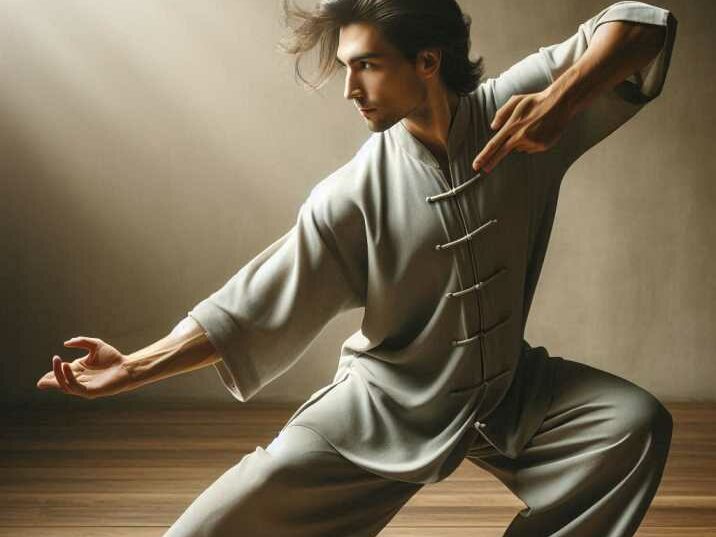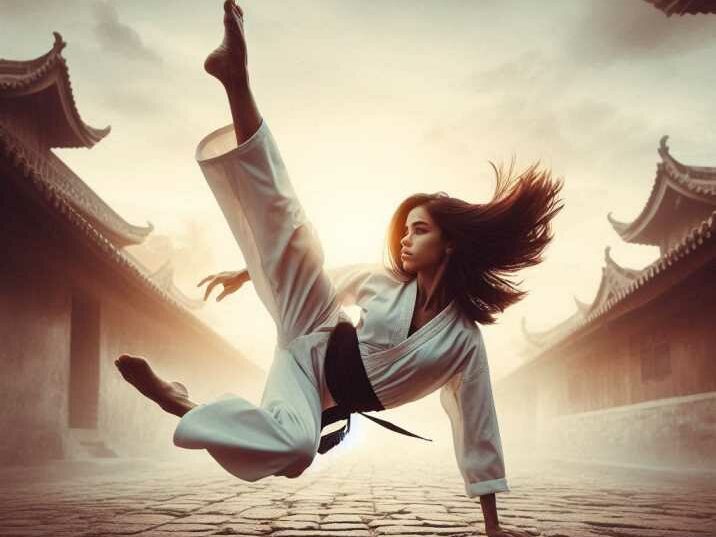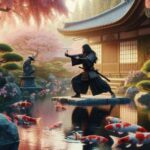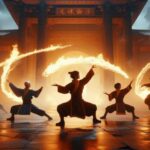Introduction
Table of Contents
“Avatar: The Last Airbender” is a popular animated series known for its unique and imaginative world, where people can bend the elements: water, earth, fire, and air. Airbending, one of the show’s four elemental bending styles, is particularly fascinating because of its graceful and fluid movements. But did you know that airbending is inspired by real martial arts? This article explores the martial arts that influenced the depiction of airbending in the show, offering insights into the techniques and philosophies that shape this captivating art form.

What is Airbending?
Airbending is a fictional martial art featured in “Avatar: The Last Airbender,” a series created by Michael Dante DiMartino and Bryan Konietzko. In the show, airbenders have the ability to control and manipulate air, allowing them to create powerful gusts of wind, perform amazing aerial acrobatics, and achieve incredible feats of agility.
Airbending is known for its emphasis on speed, agility, and fluidity, making it one of the most visually captivating bending styles in the series. To create such an elegant and dynamic style, the show’s creators drew inspiration from several real-world martial arts.
The Philosophy Behind Airbending
Overview: Airbending is not just about physical movements; it’s also deeply rooted in philosophical concepts. The philosophy behind airbending emphasizes freedom, flexibility, and detachment, aligning with the broader themes of the air nomads’ way of life.
Influence of Taoism: Taoism, an ancient Chinese philosophy, emphasizes living in harmony with the Tao (the Way), which aligns with the principles of airbending. Airbenders’ movements reflect the Taoist ideas of flowing with the natural rhythm of life and adapting to circumstances with ease.
Influence of Zen Buddhism: Zen Buddhism focuses on achieving a state of enlightenment through meditation and mindfulness. The airbenders’ calm and serene demeanor mirrors the Zen practice of mindfulness and the pursuit of inner peace.
Airbending Techniques and Their Real-World Comparisons
**1. Air Scooter: The air scooter is a technique where the airbender creates a spinning disc of air that they can ride on. This technique showcases a blend of agility and control.
Real-World Comparison: The concept of the air scooter can be compared to certain acrobatic moves in martial arts that involve balancing and controlling one’s body in mid-air, such as those found in Capoeira.
**2. Gliding: Airbenders use gliding to move through the air and reach high places.
Real-World Comparison: The smooth and controlled gliding of airbenders is reminiscent of the acrobatic jumps and aerial maneuvers in martial arts like Capoeira and the fluid movements in Tai Chi.
**3. Air Spouts: Airbenders create powerful bursts of air to push objects or opponents away.
Real-World Comparison: This technique can be likened to the powerful, focused strikes in Xing Yi Quan, where direct energy is used to impact an opponent or an object.
Historical Context of the Martial Arts
Tai Chi: Originating in China, Tai Chi was developed as a martial art and has since become known for its health benefits. Its principles of yin and yang and its slow, meditative movements are reflective of the balance seen in airbending.
Bagua Zhang: This martial art dates back to the 19th century and is known for its circular walking and intricate footwork. It was influenced by Daoist philosophy and practices, which emphasize harmony and adaptability.
Xing Yi Quan: Xing Yi Quan has ancient roots in Chinese martial arts and is known for its aggressive, straightforward techniques. It was developed during the Song Dynasty and is based on the Five Elements theory.
Capoeira: Developed by African slaves in Brazil, Capoeira combines elements of dance, combat, and music. It has a rich history and was used both as a form of self-defense and a way to preserve cultural heritage.
Aikido: Founded in the early 20th century by Morihei Ueshiba, Aikido focuses on blending with an opponent’s movements and redirecting their energy. It was influenced by traditional Japanese martial arts and philosophy.
Cultural Impact of Airbending
Influence on Popular Culture: Airbending and the other bending styles in “Avatar: The Last Airbender” have influenced various aspects of popular culture, including martial arts demonstrations, cosplay, and fan art. The series has introduced many to the beauty of these traditional martial arts and their philosophical underpinnings.
Educational Value: The incorporation of real martial arts into the show provides educational value, offering viewers a glimpse into the cultural and philosophical aspects of these practices. It also promotes an appreciation for the rich history and diversity of martial arts.
The Martial Arts Behind Airbending
1. Tai Chi
Overview: Tai Chi is a traditional Chinese martial art known for its slow, deliberate movements and focus on balance and internal energy. Practitioners move in a continuous, flowing manner, which aligns with the smooth and graceful nature of airbending.
Influence on Airbending: The fluid, circular motions of Tai Chi are mirrored in the airbenders’ ability to manipulate air with gentle, sweeping gestures. The emphasis on balance and control in Tai Chi helps to reflect the calm and centered demeanor of the airbenders.
Key Techniques:
- Push Hands: A practice in Tai Chi where two practitioners push against each other to develop sensitivity and responsiveness.
- Slow Movements: Movements performed slowly to improve control and internal energy flow.
2. Bagua Zhang
Overview: Bagua Zhang is a Chinese martial art characterized by its circular movements and dynamic footwork. It focuses on constant motion and evasion, allowing practitioners to move smoothly and unpredictably.
Influence on Airbending: The circular footwork and evasive techniques of Bagua Zhang are evident in the airbenders’ ability to maneuver quickly and fluidly, avoiding attacks while delivering powerful counter-strikes.
Key Techniques:
- Circle Walking: Practicing movements in a circular pattern to improve agility and adaptability.
- Twisting: Utilizing body rotation to generate power and maintain fluidity.
3. Xing Yi Quan
Overview: Xing Yi Quan is known for its direct and linear movements, emphasizing powerful strikes and strong, focused energy. It is one of the oldest martial arts in China and is based on five elemental forms.
Influence on Airbending: The focus on direct, purposeful movements in Xing Yi Quan is reflected in the airbenders’ ability to create strong gusts of wind with precise control. The straightforward approach to combat aligns with the airbenders’ need for both agility and strength.
Key Techniques:
- Five Elements: The practice of five basic forms representing different elements and energies.
- Straight Punches: Powerful, direct strikes that emphasize focus and strength.
4. Capoeira
Overview: Capoeira is a Brazilian martial art that combines elements of dance, acrobatics, and music. It is known for its fluid, rhythmic movements and impressive aerial techniques.

Influence on Airbending: The dance-like quality of Capoeira, with its emphasis on acrobatic movements and smooth transitions, mirrors the aerial prowess and agility of airbenders. The fluidity and grace of Capoeira contribute to the elegant and dynamic portrayal of airbending.
Key Techniques:
- Kicks: High, sweeping kicks that showcase agility and flexibility.
- Spins: Rotational movements that add flair and fluidity to the practice.
5. Aikido
Overview: Aikido is a Japanese martial art focused on using an opponent’s energy and movements against them. It emphasizes fluid motion, joint locks, and throws to neutralize attacks without causing harm.
Influence on Airbending: The principle of redirecting an opponent’s energy in Aikido aligns with the airbenders’ ability to control and direct air currents. The seamless, non-aggressive nature of Aikido reflects the peaceful and balanced approach of airbending.
Key Techniques:
- Joint Locks: Techniques that involve manipulating an opponent’s joints to control or incapacitate them.
- Throws: Using an opponent’s momentum to perform throws and redirections.
Table of Information
| Martial Art | Influence on Airbending | Key Techniques |
|---|---|---|
| Tai Chi | Focus on fluid, circular movements and balance | Push hands, slow movements |
| Bagua Zhang | Emphasis on circular footwork and evasive maneuvers | Circle walking, twisting |
| Xing Yi Quan | Direct, linear movements with strong, focused strikes | Five elements, straight punches |
| Capoeira | Dance-like, acrobatic movements that flow smoothly | Kicks, spins, fluid motions |
| Aikido | Techniques focusing on redirecting opponents’ energy | Joint locks, throws |
Conclusion
The world of “Avatar: The Last Airbender” is rich with cultural references and martial arts inspirations. Airbending, with its graceful and dynamic movements, draws heavily from real-world martial arts such as Tai Chi, Bagua Zhang, Xing Yi Quan, Capoeira, and Aikido. Each of these arts contributes unique elements to the portrayal of airbending, from fluid circular motions to acrobatic aerial maneuvers. By understanding the martial arts behind airbending, fans can gain a deeper appreciation for the artistry and creativity involved in bringing this captivating element to life.
FAQ
1. What is airbending in “Avatar: The Last Airbender”?
Airbending is the ability to control and manipulate air, allowing characters to perform feats such as flying, creating gusts of wind, and moving with great agility.
2. Which martial art inspired the circular movements of airbending?
Bagua Zhang, known for its circular footwork and evasive techniques, inspired the circular and fluid movements seen in airbending.
3. How does Tai Chi influence airbending?
Tai Chi’s slow, deliberate movements and focus on balance and internal energy are reflected in the graceful and controlled motions of airbending.
4. What role does Capoeira play in airbending?
Capoeira’s acrobatic and dance-like movements contribute to the fluid and dynamic nature of airbending, enhancing its visual appeal.
5. How does Aikido relate to airbending?
Aikido’s principles of redirecting an opponent’s energy and fluid motion are similar to the way airbenders control and direct air currents.


